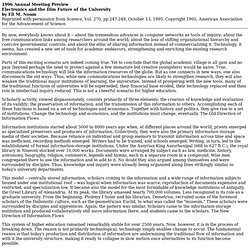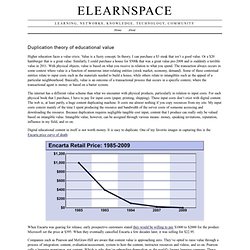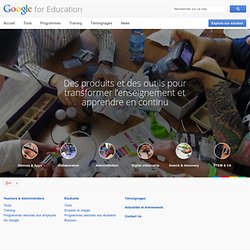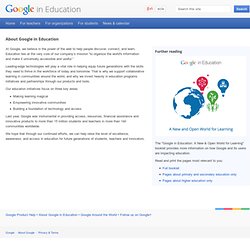Zoom
Trash

Iowa, Did You Know? STOP STEALING DREAMS. Shifthappens - versions. Noam. 1996 Annual Meeting Preview Electronics and the Dim Future of the University by Eli M.

Noam Reprinted with permission from Science, Vol. 270, pp 247-249, October 13, 1995. Copyright 1995, American Association for the Advancement of Science. By now, everybody knows about it -- about the tremendous advances in computer networks as tools of inquiry; about the free communication links among researchers around the world; about the loss of stifling organizational hierarchy and coercive governmental controls; and about the ethic of sharing information instead of commercializing it. Technology, it seems, has created a new set of tools for academic endeavors, strengthening and enriching the existing research environment. Parts of this exciting scenario are indeed coming true. Information institutions started about 5000 to 8000 years ago when, at different places around the world, priests emerged as specialized preservers and producers of information.
None of this is new, of course. Eli M. Duplication theory of educational value. Higher education faces a value crisis.

Value is a fuzzy concept. In theory, I can purchase a $3 steak that isn’t a good value. Or a $20 hamburger that is a great value. Similarly, I could purchase a house for $500k that was a great value pre-2008 and is suddenly a terrible value in 2011. With physical objects, value is based on what you receive in relation to what you spend.
The internet has a different value scheme than what we encounter with physical products, particularly in relation to input costs. Horizon Report > 2012 Higher Ed Edition. Login or Create New Account Member Spotlights RIT Launches Nation’s First Minor in Free and Open Source Software and Free Culture NMC Blog The 7 Things You Need to Openly Engage with Your Community iTUNES U Ideas that Matter and More High Quality, Free EdTech Content.

Horizon Reports. Luis von Ahn: Massive-scale online collaboration. Innovation Expert John Seely Brown on New Ways of Learning in a Rapidly-Changing World. Chris Anderson: How web video powers global innovation. Techyredes_article_pierre-levy.pdf. Tim Berners-Lee: The year open data went worldwide. Steven Johnson: Where good ideas come from. WHERE GOOD IDEAS COME FROM by Steven Johnson.
WHERE GOOD IDEAS COME FROM by Steven Johnson (Español - Spanish) Technotroubadours and Teacherpreneurs by Amy Burvall on Prezi. Educator Resources – Google in Education. Tablets with Google Play for Education With tablets and Google Play for Education, teachers can now discover, purchase, and share educational apps, videos, and a selection of top classic books.

Accéder au site Chromebooks for Education Les Chromebooks sont des ordinateurs portables rapides permettant aux étudiants d'accéder aux outils et aux ressources pédagogiques du Web. Ils sont faciles à gérer et abordables, à partir de 229 $ USD, Google Apps for Education inclus. Accéder au site Google Apps for Education Google Apps comprend tous les outils dont un établissement a besoin pour être efficace, notamment une messagerie électronique, un agenda, des éditeurs de documents, et plus encore. Accéder au site. About – Google in Education. At Google, we believe in the power of the web to help people discover, connect, and learn.

Education lies at the very core of our company’s mission “to organize the world's information and make it universally accessible and useful.” Leading-edge technologies will play a vital role in helping equip future generations with the skills they need to thrive in the workforce of today and tomorrow. That is why we support collaborative learning in communities around the world, and why we invest heavily in education programs initiatives and partnerships through our products and tools.
Our education initiatives focus on three key areas: Making learning magical Empowering innovative communities Building a foundation of technology and access Last year, Google was instrumental in providing access, resources, financial assistance and innovative products to more than 15 million students and teachers in more than 140 communities worldwide. Powered by Google Docs. L. Brainstorm and mind map online.
MindMeister. KnowingKnowledge_LowRes.pdf.